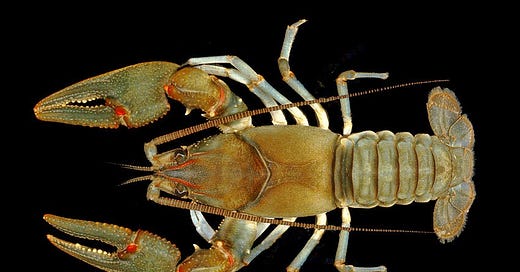News of the week
Protecting Appalachian crayfish. A plastic tipping point. Saving rainforest in Bolivia. Rewilding with grasshoppers. And more!
Protections for Appalachian crayfish
In July, one of our News of the Week topics was the invasive red swamp crayfish and the troubles it was creating in different parts of the world. This week we switch gears. Instead of seeing how folks fend off an invasive crayfish, we’ll look at how native crayfish are being protected in Appalachia.
Back in 2015, I wrote about the push to protect two kinds of crayfish that live in the streams of Appalachia. In response to a petition and lawsuit from the Center For Biological Diversity, the Fish and Wildlife Service proposed Endangered Species status for the The Big Sandy crayfish and the Guyandotte River crayfish. The two crayfish were granted Endangered Species protections by the Service in 2016.
Both crustaceans have suffered from reductions in their ranges. The Big Sandy crayfish enjoys only about 60 percent of its former range and is found in only two river networks in southwestern Virginia, southwestern West Virginia, and eastern Kentucky. More than 90 percent of the Guyandotte River crayfish’s range is now gone. This crayfish is found now only in Wyoming County in West Virginia.
The Center For Biological Diversity is again suing the FWS, this time for failing to promptly designate critical habitat for the crayfish. In 2020, the FWS proposed 445 miles of streams as critical habitat for the creatures (under pressure from a lawsuit by, you guessed it, the Center For Biological Diversity) but has yet to finalize the protections.
The crayfish in Appalachia, as well as other aquatic organisms, have suffered greatly because of coal mining through the region. Since the 1970s, coal companies have blown the tops off of mountains for the coal underneath—the process is called mountaintop removal—with the resulting rocks and dirt thrown into adjacent streams. As of ten years ago, the mines had buried more than 1,200 miles of mountain streams. In the last ten years that number has more than likely doubled.
Rain and snow that fall on the mines come in contact with sulfur-bearing minerals, creating sulfuric acid. The resulting runoff can be so acidic that it can kill all life in the streams that receive drainage from the mines. With so much going against the crayfish, let us hope that the FWS acts quickly to designate the creatures’ habitat as critical. (Center For Biological Diversity)
More news
Brief synopses of this week’s environmental news. For more information click the links.
Big cat sanctuaries can be less than they seem
Populations of big cats in Africa have dwindled in recent decades: lions have declined by 40 percent and leopards by 30 percent. The range of cheetahs has diminished by over 90 percent. The International Union for Conservation of Nature lists all three species as Vulnerable.
People are heartened by big cat sanctuaries, but they are often less than they seem and can actually cause more harm. (African Wildlife Foundation)
Another tipping point: this time it’s plastic
In a newly published paper from the journal Science, a team of researchers gives evidence that we are creating so much plastic, and it is accumulating in some parts of the planet to such a degree, that damage from the pollution may be irreversible. From the paper’s abstract the researchers say:
Plastic pollution accumulating in an area of the environment is considered “poorly reversible” if natural mineralization processes occurring there are slow and engineered remediation solutions are improbable. Should negative outcomes in these areas arise as a consequence of plastic pollution, they will be practically irreversible. Potential impacts from poorly reversible plastic pollution include changes to carbon and nutrient cycles; habitat changes within soils, sediments, and aquatic ecosystems; co-occurring biological impacts on endangered or keystone species; ecotoxicity; and related societal impacts.
For more information on the paper, you can check out this explainer from Oceana. (Oceana)
Two million acres of Bolivian rainforest saved from deforestation and fire
Through a partnership between an indigenous organization and Selfless by Hyram, a skincare company, two million acres, an area larger than the state of Rhode Island, is being set aside and saved from deforestation and fire. (Rainforest Trust)
Rewilding Europe includes invertebrates
Once common throughout United Kingdom, the large marsh grasshopper is rarely seen today, having been extirpated from most of its range. In a rewilding effort, the insect is being reintroduced to the marshes of Norfolk, with the hope of reestablishing a network of habitats throughout the islands in order for the species to sustain itself. (Rewilding Europe)
Renewed hope for the world’s mangroves
The Global Mangrove Alliance, in their latest report on the state of the world’s mangroves, finds that the rate of mangrove destruction around the world has slowed. Among their findings is that 42 percent of all mangrove are in protected areas. (Wetlands International)
Group creates wildlife corridor in Montana
In recent years, the wild lands of Montana have been beset by development. Bucking this trend is the Yellowstone to Yukon Conservation Initiative, which seeks to establish an “interconnected system of wild lands and waters stretching from Yellowstone to Yukon.”
Working with the Vital Ground Foundation, Yellowstone to Yukon just purchased 80 acres near the confluence of the Bull River and Clark Fork River, which will serve to maintain a wildlife corridor for grizzly bears and other wildlife. (Yellowstone to Yukon Conservation Initiative)
For more environmental news you can find me on Twitter at @EcoScripsit.





